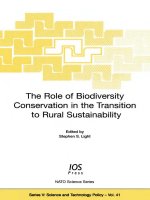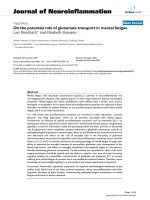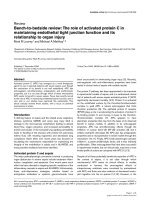Review on role of nano-micro nutrients in vegetable crops
Bạn đang xem bản rút gọn của tài liệu. Xem và tải ngay bản đầy đủ của tài liệu tại đây (155.22 KB, 6 trang )
Int.J.Curr.Microbiol.App.Sci (2019) 8(10): 277-282
International Journal of Current Microbiology and Applied Sciences
ISSN: 2319-7706 Volume 8 Number 10 (2019)
Journal homepage:
Review Article
/>
Review on Role of Nano-Micro Nutrients
in Vegetable Crops
S. P. Mishra1*, A. K. Padhiary2, A. Nandi3 and A. Pattnaik3
1
Krishi Vigyan Kendra (OUAT), Jajpur, Odisha, India
Krishi Vigyan Kendra (OUAT) Chiplima, Sambalpur, 768026, Odisha, India
3
Dept. Vegetable Science, Odisha University of Agriculture and Technology, Bhubaneswar,
Odisha, India
2
*Corresponding author
ABSTRACT
Keywords
Fertilizer, Nano
Agriculture, Salt
Stress, Callus,
Nano-bentonite
Article Info
Accepted:
04 September 2019
Available Online:
10 October 2019
Nanotechnology has been defined as relating to materials, systems and
processes which operate at a scale of 100 nm or less. Nanotechnology has
many applications in all stages of production, processing, storing,
packaging and transport of agricultural products. Nanotechnology will
revolutionize agriculture and food industry by innovation new techniques
such as: Precision farming techniques, enhancing the ability of plants to
absorb nutrients, more efficient and targeted use of inputs, disease detection
and control diseases, withstand environmental stress and effective systems
for processing, storage and packaging.
Introduction
Indian Agriculture is facing a wide spectrum
of constraints such as burgeoning population,
shrinking farm land, restricted availability of
water, imbalanced fertilizer application and
low soil organic carbon, besides experiencing
the fatigue of green revolution and vagaries of
climate change. About 60 per cent of our
agricultural land currently under cultivation
suffers from indiscriminate use of chemical
fertilizers and irrigation water (Palaniappan
and Annadurai, 1999). Wider use of high
dose of fertilizers and insufficient
application of organics led to negative
impacts like (i) reduction in soil fertility (ii)
destruction of soil structure, aeration and
water holding capacity (iii) occurrence of
micro nutrient deficiencies in many areas
(iv) adverse effects on soil biotic life
particularly in acidic soil (v) deterioration in
taste of the food (vi) poisoning of food with
highly toxic pesticide residues (vii)
susceptibility of soil to erosion by wind and
water and (viii) Pollution and health hazards
for human beings.
277
Int.J.Curr.Microbiol.App.Sci (2019) 8(10): 277-282
In order to efficiently address many of the
challenges ahead, we should think of an
alternate technology such as “Nano
technology” to precisely detect and deliver the
correct quantity of nutrients or other inputs
required by crops that promote productivity
with environmental safety. The word “Nano
agriculture” refers to the infusion of nano
technology or concepts and principles in
agricultural sciences so as to develop
processes and products that precisely deliver
inputs and promote productivity without
associated environmental harm. Nano
Agriculture is quite appropriate in India in the
context of changing scenarios in agricultural
production systems, which are on the verge of
transformation towards precision agriculture.
Nano-fertilizers are nutrient carriers of nanodimension ranging from 30-40 nm and capable
of holding bountiful of nutrient ions due to
their high surface area and releasing them
slowly and steadily that commensurate with
crop demands.
Siddique et al., (2015) studied the role of
Nanoparticles in Plants. Nanotechnology
opens a large scope of novel application in the
fields of biotechnology and agricultural
industries, because nanoparticles (NPs) have
unique physicochemical properties, i.e., high
surface area, high reactivity, tunable pore size,
and particle morphology. Nanoparticles can
serve as “magic bullets”, containing
herbicides, nano-pesticide fertilizers, or genes,
which target specific cellular organelles in
plant to release their content. Despite the
plenty of information available on the toxicity
of nanoparticles to plant system, few studies
have been conducted on mechanisms, by
which nanoparticles exert their effect on plant
growth and development. Therefore, the
present review highlights the key role of
nanoparticles
in
plants.
Moreover,
nanoscience contributes new ideas leading us
to understand the suitable mode of action of
nanoparticles in plants. The appropriate
elucidation of physiological, biochemical, and
molecular mechanism of nanoparticles in plant
leads to better plant growth and development.
Growth and Development
Ping et al., (2008) studied the effects of NanoTiO_2 Photosemiconductor on Photosynthesis
of Cucumber Plants. The mechanism of TiO2
semiconductor photocatalysis had similarity
with artificial photosynthesis. The effects of
nano-TiO2 photosemiconductor sol on the
photosynthesis of cucumber plants had been
firstly reported in this paper. Anatase TiO2
semiconductor used in the experiment was
synthesized by sol-gel methods and its effects
on photosynthesis, activities of root systems
and contents of leaf cell malondialdehyde had
been
studies
after
spray
different
concentration of nano-TiO2 sol on cucumber
leaves in culturing experiments. The
experimental results showed that nano-TiO2
sol could form perfectly adhesive, transparent,
continuing and stable films on the surfaces of
leaves by which net photosynthetic rates and
activities of root system had been significantly
promoted. These results provided some
scientific and technical references for
application of nanomaterials which using
TiO2 as effective ingredients in agricultural
research.
Jian et al., (2009) studied the Application
Research of Nano-biotechnology to Promote
Increasing of Vegetable Production. Nanobiotechnology was first used on crops in
2007,when 5 to 50 nm of carbon was added to
the fertilizer to forming Nano-fertilizer. The
experiments of fertilizer efficiency on radish,
cabbage,
cabbage,
eggplant,
peppers,
tomatoes, celery and leek crops were carried
out for the past two years. The results showed
that the fertilizer promoted the growth of the
crops, come into the market 5 to 7 days ahead
of time, and made the yield increase 20% to
40%.After fertilization the white radish grew
278
Int.J.Curr.Microbiol.App.Sci (2019) 8(10): 277-282
to 83 cm in 38 days, eggplant 1.2 kg in 20
days and so on. Nano-fertilizer could improve
the quality of the vegetables. The content of
VC in chili increased 1.5 times. Nano-carbon
was proved to be non-toxic materials by the
Chinese Center for Disease Control and
Prevention.
Fertilizer Use Efficiency
Shujuan et al., (2011). Nano-preparation on
Growth and Nitrogen Fertilizer Use Efficiency
of Cabbage. In order to improve the fertilizer
use efficiency, research and develop
environment-friendly fertilizers, which can
control the agricultural nonpoint source
pollution from the source, a soil pot
experiment was taken to study the effects of
nano-preparation on the production, nutrient
absorption, nitrogen fertilizer use efficiency,
leaf chlorophyll content and some quality
indexes of cabbage. The results showed that,
the production, leaf chlorophyll content,the
amount of nutrients (N,P,K) absorption and
nitrogen fertilizer use efficiency of cabbage
were increased by adding nano-hydroquinone
and
nano-tea-polyphenols
in
nitrogen
fertilizer, and the higher adding amount of
nano-preparation had a more obvious effect.
The best effective treatment among the four
nano-preparation treatments was the one with
4% tea-polyphenols. The production and
nitrogen fertilizer use efficiency of cabbage
were increased by 44.5% and 134.1%,
respectively. However, the effect of adding
nano-preparation on the quality of cabbage
was different, the changes of soluble sugar
content were little, the nitrate content was
increased and the Vc content had a increasing
trend. The content of Vc had no change in the
treatment 4% tea-polyphenols while its dry
weight increment was the highest. In short,
nano-preparation could increase crop yields
and improve the fertilizer efficiency.
Juan et al., (2011). Studied the effects of
nano-bentonite coated urea on growth and
nitrogen use efficiency of cabbage. A soil pot
experiment was taken to study the effects of
Nano-bentonit coated urea on the yield,
nutrient absorption, nitrogen fertilizer use
efficiency, leaf chlorophyll content and quality
indexes of cabbage. The results showed that
nano-bentonit coated urea could significantly
improve the yield of cabbage and the
accumulation of nutrients, so as the nitrogen
use efficiency. Comparing with pure urea, the
treatments applied 15% nano-bentonit coated
urea while the content of nitrogen decreased
about 10% and 20%,the nitrogen use
efficiency has also been respectively improved
about 7.9%、 8.3%;the treatments applied 20%
nano-bentonit coated urea while the content of
nitrogen decreased about 10% and 20%,the
nitrogen use efficiency respectively improved
about 3.6%、 12.6%. The cabbage chlorophyll
content of all the nitrogen treatments are
significantly higher than that of the nonnitrogen treatments, and cabbage chlorophyll
content in the treatments applied nanobentonite coated urea was higher than that in
the treatment applied conventional urea, but
the difference was not significant. Kale and
Gawade (2016). Studied the on nanoparticle
induced nutrient use efficiency of Fertilizer
and crop productivity. The experiment was
carried out in randomize dblock design with
three replications. The first treatment (T-1),
comprised of recommended dose of fertilizer
(RDF), N: P: K (50:50:50), applied at the time
of transplantation. The second treatment (T-2)
was conducted with RDF in combination @
2kg ZnSO4 (bulk)/ha. The third treatment (T3) was added, N: P: K (12.5; 12.5; 12.5) in
combination to ZnO NP @ 4500mg/ha.
The forth treatment (T-C) was without any
fertilizer. All treatments were given
appropriate quantity of nitrogen per hectare as
urea at the 30th day of transplantation. The
combination N: P: K (12.5; 12.5; 12.5) and
ZnO NP @ 4500mg/ha yielded 91% and
45.3% higher brinjal yield and biomass
respectively than the treatment with only
279
Int.J.Curr.Microbiol.App.Sci (2019) 8(10): 277-282
RDF. It was also observed that 38% and
21% higher yield and biomass respectively
were
recorded in the treatment where
combination of RDF with ZnSO4 (bulk) over
RDF was used alone. The results of field
trials reveal that, there was synergistic
effect of ZnO NP @ 4500mg per hectare
with N: P: K complex fertilizer on growth
attributes of brinjal as well as nutrient use
efficiency.
Enzyme activity
Bo et al., (2012) studied the physiological
effects under the condition of spraying nanoSiO_2 onto the Indocalamus barbatus
McClure leaves. Physiological effects under
the
condition
of
spraying
different
concentrations (0, 150, 300, 450 mg/L) of
nano-SiO_2 onto the Indocalamus barbatus
McClure leaves were studied. The results
showed that all concentrations of nano-SiO_2
treatments could increase the contents of
soluble protein, free amino acids, total
nitrogen, phosphorus, potassium, stimulate
SOD and POD activities, and decrease MDA
content. Certain correlation of concentration
and time would affect the effects.300 mg/L
nano-SiO_2 treatment got the best effect
which indicated that 300 mg/L nano-SiO_2
treatment could effectively increase the
nutritional function and the ability of
scavenging active oxygen in Indocalamus
barbatus leaves and improve the physiological
function of leaves.
Nutrient uptake
Roosta et al., (2015) studied the effect of
Nano Fe-Chelate, Fe-Eddha and FeSO4 on
Vegetative Growth, Physiological Parameters
and Some Nutrient Elements Concentrations
of Four Varieties of Lettuce (Lactuca sativa
L.) In NFT System. In order to investigate the
effects of different iron (Fe) sources (nano
iron (Fe)-chelate, Fe- ethylenediamine-di(ohydroxy phenyl acetic acid (EDDHA) and iron
(II) sulfate (FeSO4)) on lettuce (Lactuca
sativa) growth in alkaline solutions, an
experiment was arranged in hydroponic
system. This study showed that leaf Fe content
and overall plant growth was significantly
increased by Fe-chelate application, and the
highest values of leaf Fe, plant pigments and
vegetative growth were recorded in plants
treated with nano Fe-chelate. The lowest Fe,
chlorophyll, carotenoids and soluble sugars in
leaves were observed in FeSO4 treatment.
There were no difference in soluble sugars
contents of plants between nano Fe-chelate
and Fe-EDDHA treatments. Fertilization of
lettuce plants with different Fe-chelate sources
had a beneficial effect on the manganese (Mn)
and zinc (Zn) uptake in plants. It is concluded
that application of chelated form of Fe
(especially nano Fe-chelate) must be
performed in hydroponic system with alkaline
water, to overcome Fe deficiencies and to
make better nutritional status.
Vercelli et al (2015) studied the effect of Fenanosponge complex in horticulture. Iron
deficiency is a major nutritional disorder in
crops. Inorganic Fe-compounds and synthetic
Fe-chelates are commonly used to control
chlorosis but their use arise environmental
concerns.
We recently developed a new iron fertilizer
using a β-cyclodextrin-based nanosponge
complex (Fe-NS). In this study, a pilot trial
was performed on hydroponically cultivated
horticultural plants in order to evaluate the
effect of Fe-NS. Sweet corn and tomato were
used as model plants analyzing chlorophyll,
dry matter and Fe content. Fe-NS effect was
compared to FeSO4 and Fe-DTPA. Fe-NS had
a positive effect on re-greening and growth in
sweet corn and tomato plants.
Callus culture
Alharby et al., (2016). Studied the effect of
application of zinc oxide nanoparticles on callus
280
Int.J.Curr.Microbiol.App.Sci (2019) 8(10): 277-282
induction, plant regeneration, element content
and antioxidant enzyme activity in tomato
(Solanum lycopersicum mill.) under salt stress.
The properties of nanomaterials and their
potential applications have been given
considerable attention by researchers in various
fields, especially agricultural biotechnology.
However, not much has been done to evaluate
the role or effect of zinc oxide nanoparticles
(ZnO-NPs) in regulating physiological and
biochemical processes in response to salt
induced stress.
For this purpose, some callus growth traits, plant
regeneration rate, mineral element (sodium,
potassium, phosphorous and nitrogen) contents
and changes in the activity of superoxide
dismutase (SOD) and glutathione peroxidase
(GPX) in tissues of five tomato cultivars were
investigated in a callus culture exposed to
elevated concentrations of salt (3.0 and 6.0 g L1NaCl), and in the presence of zinc oxide
nanoparticles (15 and 30 mg L-1). The relative
callus growth rate was inhibited by 3.0 g L1NaCl; this was increased dramatically at 6.0 g
L-1. Increasing exposure to NaCl was associated
with a significantly higher sodium content and
SOD and GPX activities. Zinc oxide
nanoparticles mitigated the effects of NaCl, and
in this application of lower concentrations (15
mg L-1) was more effective than a higher
concentration (30 mg L-1). This finding
indicates that zinc oxide nanoparticles should be
investigated further as a potential anti-stress
agent in crop production. Different tomato
cultivars showed different degrees of tolerance
to salinity in the presence of ZnO-NPs. The
cultivars Edkawy, followed by Sandpoint, were
less affected by salt stress than the cultivar Anna
Aasa.
Fruit quality
Zhao et al., (2016) studied CeO2 and ZnO
Nanoparticles Change the Nutritional Qualities
of Cucumber (Cucumis sativus). There is lack of
information about the effects of nanoparticles
(NPs) on cucumber fruit quality. This study
aimed to determine possible impacts on
carbohydrates, proteins, mineral nutrients, and
antioxidants in the fruit of cucumber plants
grown in soil treated with CeO2 and ZnO NPs at
400 and 800 mg/kg. Fourier transform infrared
spectroscopy (FTIR) was used to detect changes
in functional groups, while ICP-OES and μ-XRF
were used to quantify and map the distribution
of nutrient elements, respectively. Results
showed that none of the ZnO NP concentrations
affected sugars; however at 400 mg/kg,
CeO2and ZnO NPs increased starch content.
Conversely, CeO2 NPs did not affect starch
content but impacted nonreducing sugar content
(sucrose). FTIR data showed changes in the
fingerprint regions of 1106, 1083, 1153, and
1181, indicating that both NPs altered the
carbohydrate pattern. ZnO NPs did not impact
protein fractionation; however, CeO2 NPs at 400
mg/kg increased globulin and decreased glutelin.
Both CeO2and ZnO NPs had no impact on
flavonoid content, although CeO2 NPs at 800
mg/kg significantly reduced phenolic content.
ICP-OES results showed that none of the
treatments reduced macronutrients in fruit. In
case of micronutrients, all treatments reduced
Mo concentration, and at 400 mg/kg, ZnO NPs
reduced Cu accumulation. μ-XRF revealed that
Cu, Mn, and Zn were mainly accumulated in
cucumber seeds. To the best of the authors’
knowledge this is the first report on the
nutritional quality of cucumber fruit attributed to
the impact of CeO2 and ZnO NPs.
Khot et al., (2012), studied the applications of
nanomaterials in agricultural production and
crop Protection.
Recent manufacturing advancements have led to
the fabrication of nanomaterials of different
sizes and shapes. These advancements are the
base for further engineering to create unique
properties targeted toward specific applications.
Historically, various fields such as medicine,
environmental science, and food processing
have employed the successful and safe use of
nanomaterials.
281
Int.J.Curr.Microbiol.App.Sci (2019) 8(10): 277-282
However, use in agriculture, especially for plant
protection and production, is an under-explored
area in the research community.
Preliminary studies show the potential of
nanomaterials in improving seed germination
and growth, plant protection, pathogen
detection, and pesticide/herbicide residue
detection. This review summarizes agricultural
applications of nanomaterials and the role these
can play in future agricultural production.
References
Ping Z,Haixin C, Zhijuan Z, Rugang Z. (2008 ).
Effects
of
Nano-TiO2
Photosemiconductor on Photosynthesis of
Cucumber Plants, Journal of Northeast
Forestry University. 2008-08
Jian L, Yang-de Z, Zhi-ming. (2009). The
Application
Research
of
Nanobiotechnology to Promote Increasing of
Vegetable
Production,
Hubei
Agricultural Sciences. 2009-01
Shujuan W, Qiang L, Haixing S, Xiangmin R,
Jianwei P, Xiaojuan W, Zhenhua Z,
Lijun C.(2011). Effects of Nanopreparation on Growth and Nitrogen
Fertilizer Use Efficiency of Cabbage,
Chinese Agricultural Science Bulletin.
2011-13
Shu-juan W, Qiang L, Hai-xing S, Xiang-min
R, Jian-wei P, Xiao-juan W (2011).
Effects of nano-bentonite coated urea on
growth and nitrogen use efficiency of
cabbage, Journal of Hunan Agricultural
University (Natural Sciences), Bo L,
Gongsheng T, Yinfeng X, Xianlei C.
(2012). The effect of nano-SiO2 onto the
Indocalamus barbatus McClure leaves,
2011-04
Khota LR, Sankarana S, Majaa JM, Ehsania R.
(2012).
The
Applications
of
nanomaterials in agricultural production
and crop protection: A review, Crop
Protection 35 (2012) 64-70.
Siddique MH., Al-Whaibi MH., Firoz M.(2015).
Role of Nanoparticles in Plants, springer
International publishing, Switzerland.
Vercelli M, Gaino W, Contartese V, Gallo L,
Tumiatti V, Larcher F, Scariot V.
(2015). The effect of Fe-nanosponge
complex in horticulture, Acta Sci. Pol.
Hortorum Cultus, 14(2)2015, 51–58.
Alharby HF, Metwali EMR, Fuller MP,
AldhebiyaniAY (2016). The Impact of
application of zinc oxide nanoparticles
on callus Induction, plant regeneration,
element content and antioxidant Enzyme
activity
in
tomato
(Solanum
lycopersicum mill.) Under salt Stress,
Arch Biol Sci. 2016; 68(4):723-735
Zhao L, Peralta-Videa Jose R, Rico CM. (2016).
The effect of CeO2 and ZnO
Nanoparticles Change the Nutritional
Qualities of Cucumber (Cucumis
sativus), J. Agric. Food Chem.2014, 62,
2752−2759.
Kale AP, Gawade SN. (2016). Studies on
nanoparticle induced nutrient use
efficiency of fertilizer and crop
productivity,
Green
Chemistry
&Technology Letters, Vol 2, No 2.
How to cite this article:
Mishra, S. P., A. K. Padhiary, A. Nandi and Pattnaik, A. 2019. Review on Role of Nano-Micro
Nutrients in Vegetable Crops. Int.J.Curr.Microbiol.App.Sci. 8(10): 277-282.
doi: />
282









